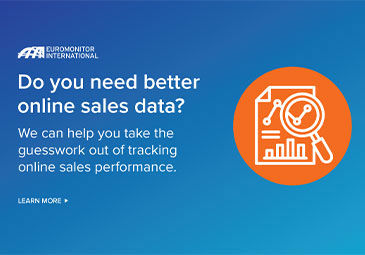Editor’s note: This article originally appeared in Forbes.
E-commerce is no longer a rising tide for all categories and brands. Online retail sales growth is coming down from pandemic-driven highs. Euromonitor International expects online product sales to record single-digit growth over each of the next five years. This rate is far lower than the more than 30% peak in 2020.
E-commerce remains a dominant force, accounting for 47% of retail growth by 2027
Source: Passport Retail, 2023
E-Customisation
Brands are putting the “custom” into “customer”. A greater desire for personalisation means offering a broader range of tailored options across online purchases. In fact, 47% of digital consumers expected better personalisation in exchange for their personal information, according to Euromonitor’s latest Voice of the Consumer: Digital Survey. Technologies like AI make it easier for brands to customise products on demand or enhance the level of individual shopping experiences.
Starbucks is a prime example of a company that has found success embracing customisation. The coffeehouse giant offers more than 170,000 customisation options on its app and noted in an earnings report that this initiative was “the single biggest driver” of increased spend per customer in history. Quick-service operators across North America and Europe are taking a page from Starbucks’ strategy to enhance the level of choices or selections offered through their own apps.
Game Changers
Online companies are tapping into gaming to drive growth. Low conversion rates plague e-commerce, with shoppers abandoning purchases due to shipping, payment or tech hurdles. Three quarters of digital consumers abandoned an online purchase last year, according to Euromonitor’s Voice of the Consumer: Digital Survey. The top reason? An unexpected shipping cost.
31% of digital consumers have abandoned a shopping cart due to unexpected shipping cost
Source: Euromonitor International Voice of the Consumer: Digital Survey, fielded March 2022
Gamifying commerce, or mimicking techniques from the gaming world to encourage a desired behaviour, uses the power of rewards and competition to inspire app activity. Companies are also integrating these features to collect valuable first-party data, which has become more difficult off the back of tighter privacy restrictions.
Boston-based start-up Jebbit offers brands the ability to add quizzes and other interactive elements to websites without engineering support. CEO Tom Coburn said that Jebbit has seen interest in these features soar over the last 18 months due to shifts in regulation and the end of third-party cookies.
Another factor: the pandemic-driven e-commerce boom and realisation that the online experience needed to adapt. “Now with platforms like TikTok capturing consumer attention, other platforms are now saying we also have to create a fun and engaging experience,” Coburn said in an interview at NRF 2023: Retail’s Big Show.
Sensory Shopping
Brands leverage technology to create multisensory customer experiences online in order to better simulate in-person shopping. E-commerce stores are being transformed with more immersive visual and auditory content. Plus, brands are beginning to push Web 3.0 forward, using tech to evoke all senses like touch, smell and taste.
Recent advancements have been driven by either the largest, most well-resourced companies or innovative start-ups. For example, beauty and personal care giant L’Oréal is using novel auditory tech to help convey the impression of scent over the internet using sound. Meanwhile, South Korean beauty company AmorePacific created a skin measuring device in collaboration with MIT that allows users to monitor their skin’s response to external stimuli, bringing the sense of touch into the digital age.
2023 could mark an inflection point. Consumers are growing more comfortable with Web 3.0, and brands are better positioned to leverage it for immersive experiences. Beauty and fashion players, which tap into a consumer’s personal style, are likely to see the greatest upside.
Three Trends to Help You Secure Online Growth
Companies that want to thrive online have to proactively target, acquire and convert a new digital consumer. In a November 2022 industry survey from Euromonitor, 45% of professionals said delivering a positive digital consumer experience was critical to success. More than ever, it is important for companies to understand digital trends and shifts in order to gain a competitive advantage and better serve customers.

